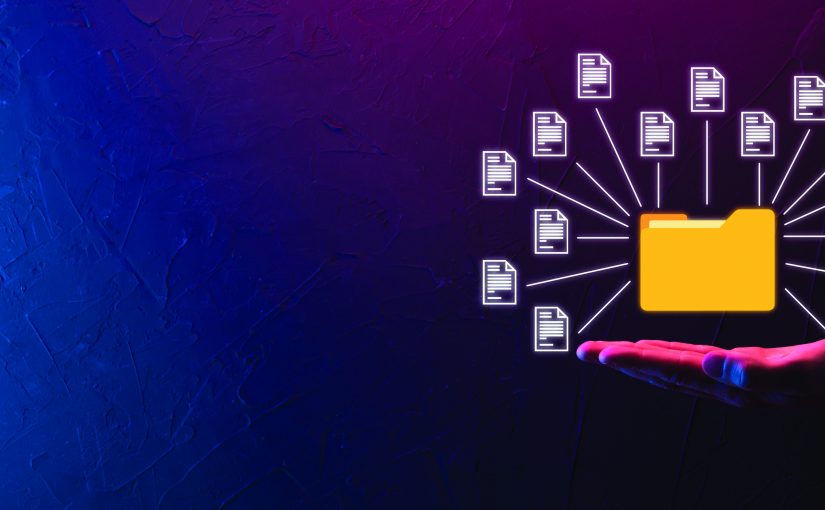Over the last couple of decades, technology has radically changed how people live and work. These technological changes have created many new challenges for law enforcement, but they have also created powerful new possibilities. Information that was once stored in filing cabinets is now usually stored in computers. Data that were once delivered through postal services are now shared online. Ideas that were once communicated through one-way media, like trade journals, are now commonly discussed through interactive media.
These increases in information technology have given the public an expectation that law enforcement will use technology to communicate and coordinate in ways that are faster and more versatile to address U.S.-wide concerns. The old-fashioned ways of sharing information are no longer the most efficient. To address the need for greater efficiency, the FBI has created JusticeConnect.
JusticeConnect is a secure platform to share and store information as a means to enhance collaboration among U.S. criminal justice, emergency management, and intelligence experts. JusticeConnect provides tools for law enforcement communities and groups to leverage each other’s knowledge and organization. These tools include ways to form groups of shared interests or concerns, distribute information, conduct research, or network with other professionals.
How to Find and Access JusticeConnect
To keep information secure, the JusticeConnect portal is accessible within the Law Enforcement Enterprise Portal (LEEP). Any law enforcement agencies or professionals with LEEP access can participate in JusticeConnect. U.S. military and intelligence professionals can also participate in JusticeConnect. A JusticeConnect profile is easy to create, and within a few minutes, the user can access JusticeConnect with a single click on the LEEP homepage.
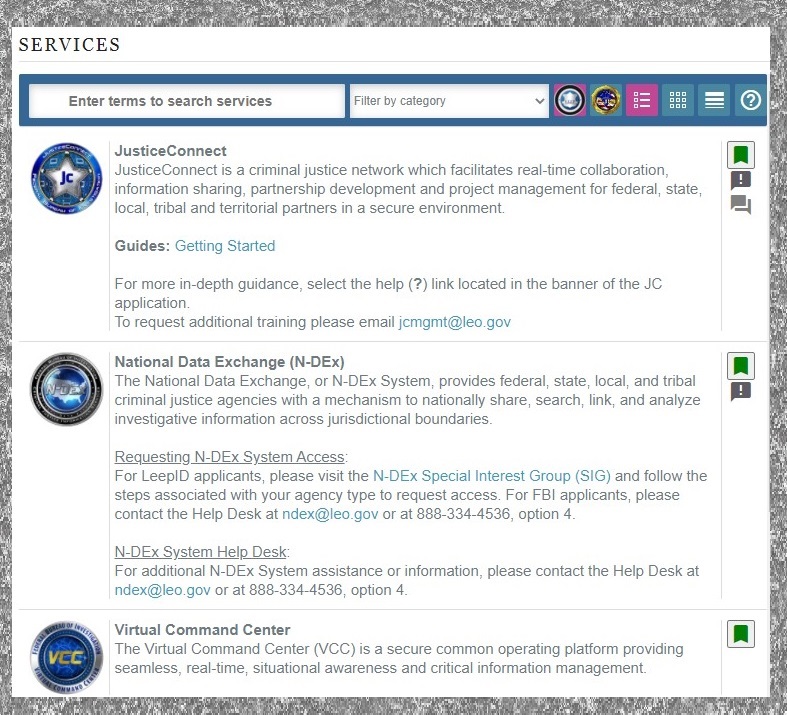
JusticeConnect Communities
JusticeConnect enables users to create communities of special interest. The following are examples of possible JusticeConnect communities:
- Law enforcement agencies across a certain area, such as the police departments in a certain state.
- Agencies of a certain category, like wildlife enforcement or highway patrol.
- Law enforcement officers of a certain category, like sheriffs or narcotics detectives.
- Law enforcement support personnel, like forensics technicians or human resource specialists.
- Anyone in law enforcement who is interested in a certain topic, like homicide investigations or community relations.
- Law enforcement professionals who are interested or involved in a certain case, like the effort to identify a terrorist or locate a fugitive.
Creating Communities
In the following example, the author created a simulated community for an interagency task force against smuggling on the Mississippi River. Creating the community took only a few minutes.

When a user creates a community in JusticeConnect, the user can choose access settings to control whether the membership is open or by invitation only. A community can have posted content that is available to anyone or limited to specific members. The user who creates a community becomes the owner of the community and can grant administrative privileges or control membership.
JusticeConnect communities are divided into three types.
- Public: Any JusticeConnect user can view content or join.
- Moderated: Any JusticeConnect user can view content, but they can only join or post content by permission.
- Restricted: Only invited members can join and view information.
These ownership and control features are important for JusticeConnect’s function as a shared tool for law enforcement. JusticeConnect is designed to be as versatile as users want it to be, so it can be useful for a wide variety of purposes. Users can create communities for criminal justice purposes, such as if a user creates a community about officer safety policies. Another user may create a community to share specific investigative information about an ongoing case.
Some of the current Communities of Interest are CJIS Advisory Process, National Crime Information Center, Law Enforcement Officers Killed and Assaulted, and FBI Office of Partner Engagement. The Law Enforcement Sensitive Communications community is a recent addition that provides a way for the FBI to share information with law enforcement partners.
When users create or join communities, JusticeConnect gives them an easy interface for tracking and monitoring them. On the My Communities screen, users can see a named list of their communities along with custom icons. Users can search their communities by keyword and see the status of their communities by most recent updates and number of members. Community owners can sort their list of communities by name, recent updates, and number of members.
Finding a Community
By clicking on the names or icons of their communities, owners can go to a screen that shows a description of the community, links to posted content, and helpful features like a tag cloud of the most common tags. Users can navigate through their community with tabs and dropdowns for a community overview, status updates, recent updates, members, files, forums, bookmarks, wikis, events, blogs, and related communities.
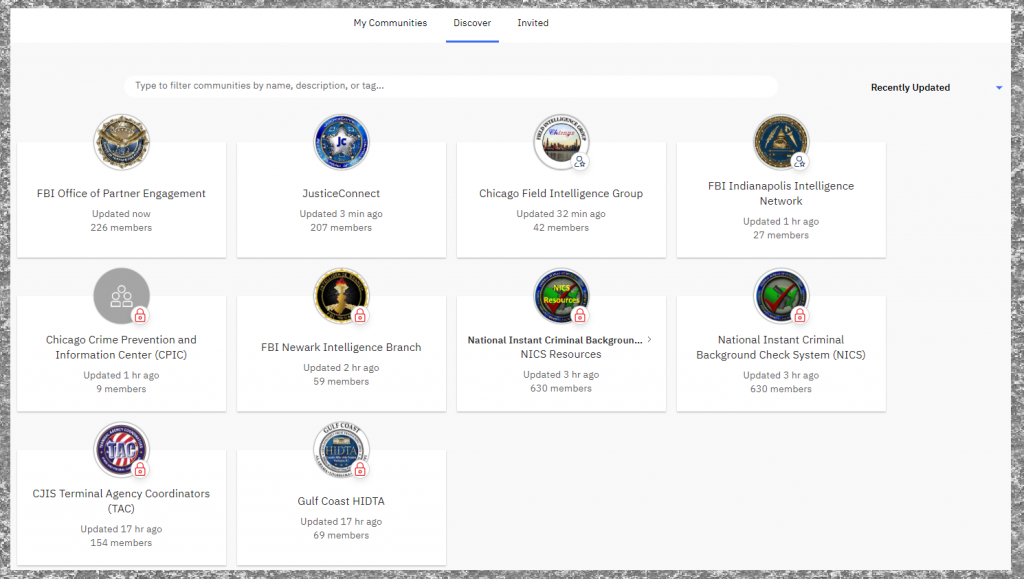
One especially useful community is devoted to JusticeConnect itself. FBI personnel administer the JusticeConnect community to share discussions, updates, and resources related to the functions of JusticeConnect. The JusticeConnect community includes blogs, answers to frequently asked questions, helpful tips from JusticeConnect administrators, and solicitations for success stories. Any users can easily find the JusticeConnect community simply by keyword searching for “JusticeConnect,” and they can join the community to receive emailed updates.
Users can browse or locate available communities using a variety of features. JusticeConnect enables users to search or filter communities by
- Their own membership or status
- Invitations
- Tags
- Keywords
- Dates of updates
- Number of members
- Name
An example would be if a user wants to find the community for the National Data Exchange (N-DEx), which gives agencies tools for sharing and locating information that can potentially link cases. A user could find the N-DEx community by searching for its name or by looking for keywords like “data.”
Copying a Community
Some users might think creating a community seems daunting and complicated. JusticeConnect contains many customizable features, but creating a community doesn’t need to be difficult. Users can choose an option called Copy a Community to make it easier. If a user likes the way a particular community looks or functions, the user can click on Community Actions and then select Copy Community from a dropdown menu. This will automatically create a new community that is formatted like the one selected. Users can copy any community they have access to—including restricted or moderated ones—but they can only copy the format or settings of a community, not its content or members.
For example, a user who likes the look of the Uniform Crime Reporting Program’s community can create their own new community with a similar look. The Copy a Community feature then gives the user a set of options to keep the existing format elements or customize new ones.
Features of JusticeConnect
Some of the useful features of JusticeConnect follow:
- Ability of users to post documents, graphics, or files that others can access
- Profile options, like photos, biographical information, contact information, topics of interest, automatic notifications, and layout preferences
- Navigational features, like search boxes, tags, bookmarks, and keyword clouds
- Ability of users to follow, unfollow, contact, or notify other users
- Ability of users to seek or provide information with other users, such as with blogs, polls, surveys, forums, and wikis
- Automatic interface features like notifications, reminders, and suggestions
Activities
One of the more powerful features of JusticeConnect is users’ ability to create and manage activities with other users. The Activity function in JusticeConnect is designed to be a project management system. An example of an activity would be a set of objectives for an interagency task force. A user can post a list of goals or tasks, assign them to specific members, and monitor their progress. In the example of an interagency task force, one member of the task force might take an assignment to track the number of incidents the task force encounters while another member might take an assignment to schedule some specialized training for task force members. The members can post updates on their progress and share information with the group. The owner of the activity can monitor their progress, provide feedback, and send reminders.
For example, the author created a simulated activity for an anti-smuggling task force. It took only a few minutes.
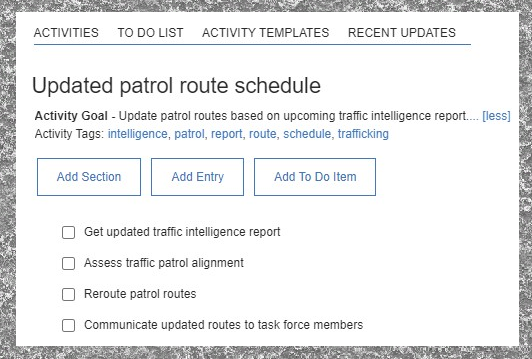
Another powerful feature of JusticeConnect is its information-sharing capability. Users can post chats, links, or wiki entries. JusticeConnect can store a variety of information types, including
- Data files
- Documents
- Audio
- Video
- Presentations
With JusticeConnect, users can easily create and update blogs for unrestricted viewing or for followers. The blogs can include free text, graphics, videos, or other types of content.
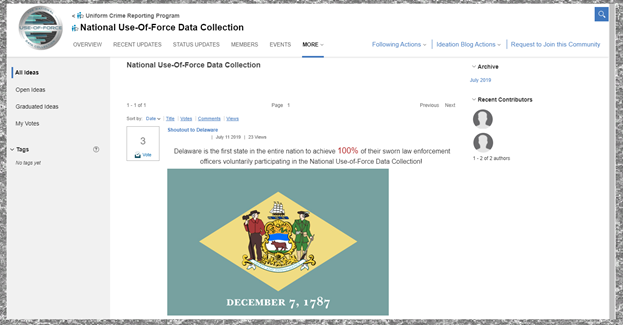
Users can find blogs by using a variety of search features. JusticeConnect enables users to find blogs within categories of their own posted blogs, publicly available ones, and their own updates. Blogs will appear in listings sorted by date, title, likes, votes, comments, or views. Users can also find the most popular or featured blogs in JusticeConnect as measured by the most liked, most voted for, most commented on, or most visited.
JusticeConnect does not interface directly with other systems like the National Crime Information Center or Next Generation Identification. However, JusticeConnect is compatible with users’ productivity suites. This means that JusticeConnect can accept and open files, like word processing documents, spreadsheets, slide decks, or audiovisual media. When users follow communities or set reminders, they can receive notifications in their normal email.
How to Get Started with JusticeConnect in LEEP
JusticeConnect is available as a standard feature for LEEP users. In addition to being the gateway to JusticeConnect, LEEP is also a portal to a wide variety of resources and services.
- The Virtual Command Center (VCC) is a secure common operating platform providing seamless, real-time, situational awareness and critical information management.
- The National Data Exchange, or N-DEx System, provides U.S. federal, state, local, and tribal criminal justice agencies with a mechanism to nationally share, search, link, and analyze investigative information across jurisdictional boundaries.
- The National Gang Intelligence Center (NGIC) is a multiagency effort that integrates gang information from U.S. local, state, and federal law enforcement entities to serve as a centralized intelligence resource for gang information and analytical support.
To learn more about LEEP, please visit the FBI’s LEEP webpage, where users can find descriptions of LEEP services, LEEP help desk contact information, and links to informative documents, like the LEEP brochure. To gain access to LEEP, law enforcement agencies and criminal justice professionals can go to the LEEP login portal and click on Apply for an Account. Once users have LEEP access, they can simply click on the JusticeConnect tab in LEEP to get started. Users who need assistance can contact the LEEP help desk at 888-334-4536 or email at helpdesk@leo.gov.
 Jeffrey Fisher is a writer-editor who has worked for the FBI since 1997 as a biometrics expert, a manager, and a writer. He has an MS from West Virginia University and has authored many articles about the FBI’s crime statistics, data sharing, and identification services. He can be reached at jfisher2@fbi.gov. Jeffrey Fisher is a writer-editor who has worked for the FBI since 1997 as a biometrics expert, a manager, and a writer. He has an MS from West Virginia University and has authored many articles about the FBI’s crime statistics, data sharing, and identification services. He can be reached at jfisher2@fbi.gov. |
Please cite as
Jeffrey Fisher, “Linking Law Enforcement with JusticeConnect ,” Police Chief Online, June 8, 2022.


